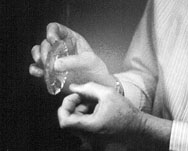
To determine a genuine cup plate, plink the plate near the edge while holding it in the center. The ring will be a clear resonating and rolling tone. Also look for the usual edge chipping and normal wear on the bottom.
The United States played a pivotal role in pressed glass development starting at about 1825. The guiding force and major developer was a New Englander named Deming Jarvis. He was first president of the New England Glass Company and next founded the Boston and Sandwich Glass Works.
Most of the pressed tablewares were flint until the Civil War. The demand of lead for bullets became so great that the glass industry had to adopt a non-lead based glass. About 1860 a new lime glass process was developed that produced a "harder glass" with good clarity. The advantage of lead was it produced a "soft glass" that was easy to work, cut, polish, and grind. It also made for excellent clarity and gave a ring when plinked. The disadvantage was the glass was easily chipped and cracked. Consequently perfect examples of flint glass are nearly impossible to find. Collectors of flint will generally accept damaged specimens while shunning post-flint examples.
The first pieces from 1825 through about 1830 tended to be fairly crude. Plates frequently will be very thick and some have opposite edges which have different thicknesses. This was caused by a poorly aligned mold. Also kilns were fired by wood or coal so temperature control was very poor causing a lot of rejected product and also straw lines and waviness in the glass.
About 1832 the glass pressers came up with the idea of making intricate patterns which would mask or hide defects in the glassware. This is known as the "lacy period" which lasted from about 1832 to about 1845. This period saw some of the most intricate and beautiful patterns ever made. As expertise and processes improved, the move was made away from the intricate patterns to very plain ones. The period from 1845 to 1862 saw high quality product with some of the most collectible and copied patterns ever produced.
Public demand was considerably different from 1825 to 1862 and the kinds of things that were made reflected those times. One popular product was the cup plate. it was acceptable etiquette to pour one's coffee into the saucer to cool and then place the cup on a cup plate. There were hundreds of different patterns made both in New England and glass factories in the "midwest" which at that time meant western Pennsylvania and eastern Ohio. Many cup plate patterns were copied by the various contemporary glass houses and later on by modern manufacturers such as Westmoreland Glass Company.

To determine a genuine cup plate, plink the plate near the edge while holding it in the center. The ring will be a clear resonating and rolling tone. Also look for the usual edge chipping and normal wear on the bottom.
Unfortunately the most current book on cup plates is Ruth Webb Lee's book written and revised in the 1940s. There is a copy in the Galesburg Public Library.
If you've got any collectible items you'd like to learn more about, send a note to Jim Woods, Collector, at the Zephyr, P.O. Box 1, Galesburg, IL 61402 or to zephyr@misslink.net.